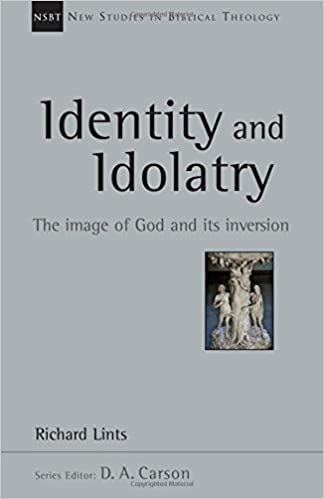A Brief Book Summary from Books At a Glance
by Steve West
About the Author
Richard Lints is a dean and professor at Gordon-Conwell Theological Seminary (Hamilton Campus). He has written a number of influential books on a variety of theological and philosophical themes.
Introduction
Identity and Idolatry is part of the New Studies in Biblical Theology series. It explores the biblical understanding of the imago Dei. Lints pays careful attention to the immediate context in which the phrase “image and likeness” first appears in Genesis, and then explores the linkage between the image of God and its inversion in idolatry.
Table of Contents
Chapter 1 Living Inside the Text: Canon and Creation
Chapter 2 A Strange Bridge: Connecting the Image and the Idol
Chapter 3 The Liturgy of Creation in the Cosmic Temple
Chapter 4 The Image of God in the Temple Walls
Chapter 5 Turning the Imago Dei Upside Down: Idolatry and the Prophetic Stance
Chapter 6 Inverting the Inversion: Idols and the Perfect Image in the New Testament
Chapter 7 The Rise of Suspicion: The Religious Criticism of Religion
Chapter 8 Significance and Security in a New Key
Summary
Chapter 1: Living Inside the Text: Canon and Creation
Movies and books provide us with images and conceptual worlds that help shape our thinking and perceptions. Although certain media are new, this structuring and re-structuring of our understanding of reality has always been something that storytellers throughout history and in different cultures have tried to accomplish. Images are extremely powerful and formative. Human nature is not limitlessly fluid or merely a subjective, cultural creation. There are fixed points to human nature because of our creation in the image of God. Culture shapes our perceptions, but our ontology is not infinitely malleable. Our perceptions shape how we interpret the world; our understanding is filtered through our expectations and narrative lenses. We exist in a web of relationships, and we are able to perceive ourselves as both subject and object. Persons and societies mutually create each other. Human identity reflects both the world and the God who made us. God has created the world filled with analogies to represent himself; both words and images communicate meaning in creation.
Human beings are created in the image of God, but the Bible does not elaborate greatly on the theological meaning of this phrase. It is more of a methodological or hermeneutical principle, bearing with it the basic meaning that as a mirror reflects an image, we image God. A mirror may give a distorted reflection/image, but its nature is to reflect. When we read Scripture we should look to see how humans reflect and distort the character of God. The imago Dei is more about human identity and meaning than pure ontology. It is not about our ontological attributes but about our significance and meaning. Human identity isn’t a description of attributes, but rather significance in social relationship, including our relationship with God. We need to let Scripture give us answers as well as frame the right questions—we are not to try to create a full philosophical anthropology out of the slender resources in the Bible. The canon is the unified word of the triune God, and the parts and whole mutually inform one another. It is essential in biblical theology and interpretation to see both the forest and the trees. Scripture represents an incredibly rich theological drama with a discernible plotline (although the metaphor of a drama must not be overextended in its application to Scripture). Unity and diversity are essential in the Trinity and the canon, as well as for human identity in relationship. The Bible does not teach individualism: it positions us as social beings. Our identity is rooted in our relationship to God, but God’s identity isn’t rooted in us. Image is a relational concept that connects the image (us) to the original (God), and idolatry distorts that relationship and reflection. . . .
[To continue reading this summary, please see below....]The remainder of this article is premium content. Become a member to continue reading.
Already have an account? Sign In
